HP Z6 G5 A Workstation Review: 96-Core AMD Ryzen Threadripper Pro 7995WX Impresses
by Gavin Bonshor on December 13, 2023 9:40 AM ESTClosing Thoughts
When it comes to workstations, a large number of them resemble conventional desktop systems on the outside, but inside, that isn't the case. Workstation OEMs such as HP, Lenovo, and Dell compete at the high end, looking to provide their customers with the best solutions designed for highly intensive multi-threaded tasks. These include video editing, 3D rendering, engineering design, and machine learning/AI. Until now, most of the vendors optimized their workstations for previous generations of Threadripper, such as the Pro 5000 series and Intel's current Sapphire Rapids-based Xeon W-3400 series. That could all be set to change...
Enter AMD's latest Ryzen Threadripper Pro 7000 series, with all of the bells and whistles required for the latest and cutting edge workstation related tasks, with the Threadripper Pro 7995WX and 96C/192T of powerful and efficient Zen 4 goodness inside, looking to take the competition to Intel in the workstation market. Built on the foundation of their Zen 4 microarchitecture and fabbed on TSMC's 5 nm node, AMD is looking to bridge the gap in the middle market between desktops (Ryzen 7000) and servers (EPYC 9004) with a powerful yet highly effective workstation platform for users to sink their teeth into.
While AMD has launched the Ryzen Threadripper Pro 7000 series through four OEMs (more than previous generations), this goes to show that OEMs are happy to hedge their bets on AMD's Zen 4 workstation platform, especially as their customers are typically demanding when it comes to getting the most for their money. From HP's perspective, the Z6 G5 A is their high-end premium workstation designed to bring the Ryzen Threadripper Pro 7995WX with 96 Zen 4 cores to the market, as well as offering a highly customizable system designed to tackle all of their customer's needs.
When it comes to reviewing a workstation, it's important to note that they aren't designed for everyone, and users looking for maximum single-threaded performance will find the higher clocked desktop processors more to their liking; same uArch + higher core clock speed = better single-threaded performance. The crux of a workstation in regards to performance comes down to one key ingredient, and that's multi-threaded performance. That is something AMD's Ryzen Threadripper Pro 7000 WX series brings in spades. As well, underscoring that this is a part meant for use in managed corporate workstations, TR Pro 7000 comes with AMD's PRO security features enabled for these parts. And for their part, HP includes their own Wolf Security software for an additional layer of protection.
Another aspect to consider for a system with such an amalgamation of high-end (and expensive) components is the quality of the entire product. The HP Z6 G5 A performs like a workhorse and has all the bells and whistles, making it a premium workstation for the most demanding users. The svelte and large black desktop chassis provides plenty of functionality, including a front bay where users can mount an HP Z Turbo Drive Quad Pro front bay-mounted add-in card, which provides up to four hot-swappable PCIe 5.0 x4 M.2 drives right in the front.
Some of the key features of the HP Z6 G5 A include support for all six of AMD's Ryzen Threadripper Pro 7000 WX series processors, which range from 12C/24T (7945WX), all the way up to the 96C/192T (7995WX), with support for up to 1 TB of DDR5-5600 RDIMM memory in an 8-channel (1DPC) configuration. Storage support, as expected, is vast, with support for up to 12 NVMe SSDs in total, with 6 full-length PCIe 5.0 slots making use of all those PCIe 5.0 lanes built into the processor. Given the Z6 G5 A pedigree, it can use up to three NVIDIA RTX 6000 dual-slot graphics cards or one AMD Pro W7900 graphics card simultaneously, with lower graphics capabilities also supported.
Pivoting back to security, HP includes plenty of security management features, including full-volume encryption and HP-specific technologies such as BIOSphere, Sure Run, Sure Click, Sure Admin, Sure Start, and Sure Recover, and that's not including AMD's PRO security features toolset directly integrated at the silicon level. HP's Wolf Pro Security software is added to the mix, which provides direct protection against malware, phishing, and ransomware attacks.
Ryzen Threadripper Pro 7995WX: Over 100K in CineBench R23 MT!
Looking at how the HP Z6 G5 A performs along with the Ryzen Threadripper Pro 7995WX, we opted for a cut-down version of our test suite, as the platform itself is designed primarily for intensive multi-threaded workloads, such as rendering. That being said, it was up against some stiff competition, including the previously reviewed Ryzen Threadripper 7000 series for HEDT, which is a cut-down Threadripper Pro with fewer cores, with 4-channel memory, and without all the PRO features required for enterprises and businesses. The other contender is the Intel Xeon W9-3495X (56C/112T) workstation processor based on Sapphire Rapids, and at the time of writing, is Intel's premium workstation platform and the direct competitor to Threadripper Pro 7000.
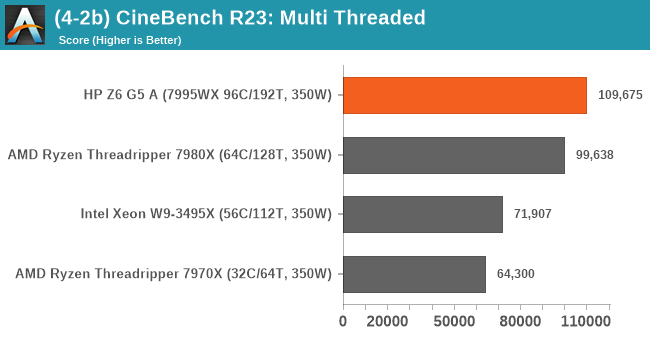
In the CineBench R23 multi-threaded test, the AMD Ryzen Threadripper Pro 7995WX is the first single-socketed processor in our suite to hit and surpass 100K points, which is an impressive feat in itself. The closest otherwise is the Ryzen Threadripper (non-Pro) 7980X (64C/128T), which marginally missed the 100K mark. Compared directly to the Intel Xeon W9-3495X (56C/112T), the Threadripper Pro 7995WX is around 34% ahead in CineBench R23 MT and represents a significant jump in performance comparing AMD's Zen 4 workstation flagship to Intel's current flagship workstation chip.
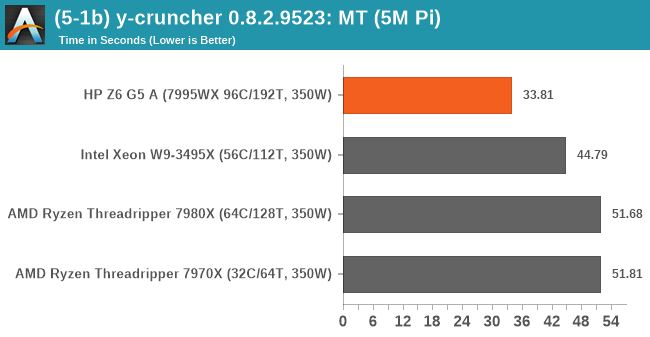
Looking at y-cruncher 0.8.2.9523's multi-threaded test performance, we can see that the Ryzen Threadripper Pro 7995WX performs around 25% quicker than the Intel Xeon W9-3495X. In heavily multi-threaded scenarios, the Threadripper Pro 7995WX has a clear and distinct advantage compared to non-Pro Threadripper 7000 and Intel's Sapphire Rapids workstation chips. Still, in many cases, such as encoding, we don't see the gains due to a lot of focus on single-threaded performance or workloads not entirely optimized for more than 32/64-threads.
Where we would typically analyze things based on an apples-to-apples cost basis of the chips, as the Threadripper Pro chips are technically OEM-only, AMD isn't offering any public pricing information. Yes, the Threadripper Pro 7995WX has 96 cores, and the EPYC 9004 variant this chip is based upon, the AMD EPYC 9654 (96C/192T), has a 1K per unit pricing of $11,805; we do expect pricing to be somewhat similar. The crux is, if the Threadripper Pro 7995WX costs around $11-12k, then this is nearly double the price of Intel's Xeon W9-3495X, which costs around $5889.
Final Thoughts: HP Z6 G5 A Renders Like a Beast, But It's Not For Everyone
In 2021, when we reviewed the Lenovo ThinkStation P620 workstation, AMD had just one launch partner for their Ryzen Threadripper Pro 3000 series processors. Fast forward to the Ryzen Threadripper Pro 7000 launch. AMD has four launch partners on board, including HP, Dell, Lenovo, and Supermicro, four of the biggest workstation OEMs in the industry. This represents a significant shift in demand for AMD's Threadripper Pro processors, which is a good indicator of AMD's sales performance in the last 2-3 years.
At the time of writing, HP has given us limited information on the pricing of their Z6 G5 A workstations, including the base price and max configuration price. We have been informed that the configuration we've reviewed today costs around $19,849. That's a considerable outlay for a workstation. Still, for users and companies with complex workloads, such as animation companies, automotive design companies, and even engineers who need performance, the price of a fast machine is often a drop in the bucket compared to the ongoing cost of a professional's time.
At Newegg (at the time of writing), the AMD Ryzen Threadripper Pro 7995WX can be purchased separately for $9999, which is a steep jump from the $6499 that Threadripper Pro 5995WX cost at launch. Sure, the 7995WX has more cores (96 vs. 64), and it has the benefit of being on Zen 4, which has a multitude of benefits, including improved IPC performance, higher core clock speeds, more L3 cache, and a more efficient CPU architecture, a dollar under 10K isn't cheap!
It's hard to deny that the HP Z6 G5 A is a very high-end workstation with plenty of supplementary inclusions such as security features, performance through the AMD Threadripper Pro 7995WX processors, which is a behemoth for multi-threaded workloads, and of course, the build quality is superb overall.
With many customization options available via HP, the Z6 G5 A is a solid workstation for users and companies looking to bolster performance in multi-threaded workloads but don't quite require the more advanced features or platform such as AMD's EYPC 9004 Genoa server range. Design-wise, the separate cooling chambered approach of the interior is something we wish we could see across the industry, and it puts the HP Z6 G5 A in the more desirable category with solid thermal and multi-threaded performance within the rendering section of our test suite.


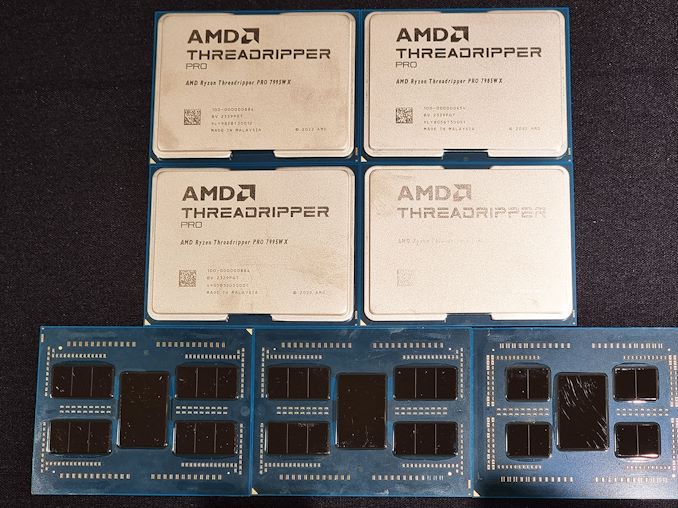
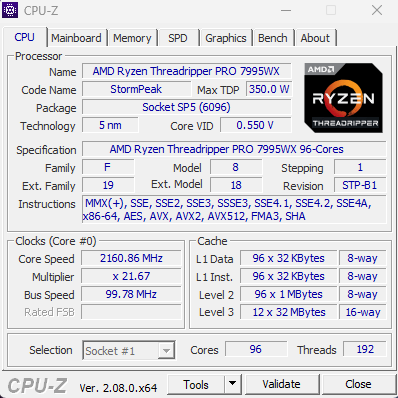
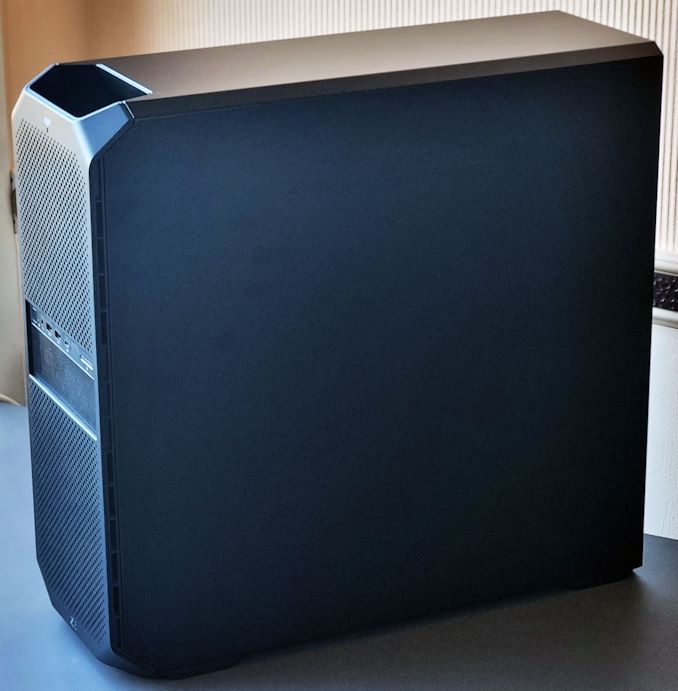
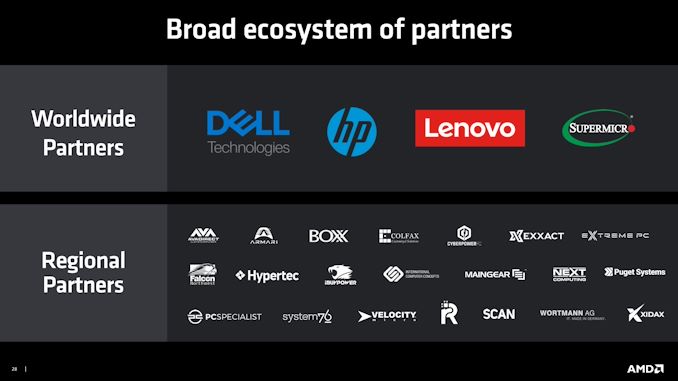








23 Comments
View All Comments
yankeeDDL - Wednesday, December 13, 2023 - link
So the Xeon is almost 2x slower at almost 2x power.It's amazing how far behind Intel has fallen.
TEAMSWITCHER - Wednesday, December 13, 2023 - link
If only people were still doing workstation rendering on CPU's....TheinsanegamerN - Wednesday, December 13, 2023 - link
If only people did things other then rendering on CPUs.schujj07 - Thursday, December 14, 2023 - link
You mean rendering or editing programs like Adobe Premiere? Premiere is still mainly CPU bound.xenol - Monday, December 18, 2023 - link
Only peak power is reported, which can exaggerate how much power Intel chips use since they have a higher power level over the TDP. They should've reported average power from a sample of workloads. Having how long each test ran would also be good to derive average energy usage.In addition, Intel's a process node behind TSMC.
Rοb - Wednesday, December 13, 2023 - link
> "We have been informed that the configuration we've reviewed today costs around $19,849.".Using the link you provided, choosing the base configuration and only changing the processor, the price is U$25,672.00.
Bare bones, with 16 cores, start around 5K.
Greg13 - Wednesday, December 13, 2023 - link
Many thanks for the review. I'm surprised you ran it with such little ram though. 128GB for 96 cores. That's barely more than 1GB per core. The workloads I'd be looking to use this on would be needing 8GB per core at least. It makes me wonder if the performance was somewhat limited by insufficient ram capacity? If these benchmarks aren't limited by such limited ram capacity, then I also think that you should look to get some new workstation benchmarks that are more memory intensive? We never seem to see the benefits of more memory channels in the benchmarks you use, which always surprises me.PeachNCream - Friday, December 15, 2023 - link
That's actually typical scaling with higher core count workstations. While the raw RAM quantity is higher than the average home PC, the per-core quantity is a lot lower as is the per-core memory bandwidth based on lots o' CPUs and not so many memory channels.Greg13 - Saturday, December 16, 2023 - link
Up until this generation with the 96-core part, Threadripper Pro has always matched the top desktop part in terms of memory channels per core. In terms of memory capacity per core, they far exceed standard desktop parts as they can have up to 2TB of RDIMM's. Which is several times more memory capacity per core than the desktop parts. However this review has chosen to review the processor with 1/20th of its maximum memory capacity which just seems odd to me and suggests that they are not testing it in its intended workload and/or limiting its performance compared to the lower core count processors which they've given the same amount of total ram.PeachNCream - Sunday, December 17, 2023 - link
To be fair, that's probably a decision at HP and not Anandtech. Anandtech hasn't purchased hardware for review in ages and is beholden to test whatever is sent to them (probably distributed by Future between AT and Tom's or shipped direct to AT - just guess on the distribution channel here) so they really can't be as flexible about that since there's just not any sort of money for reinvesting into reviews.